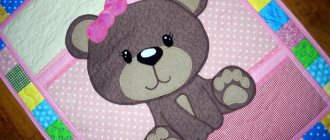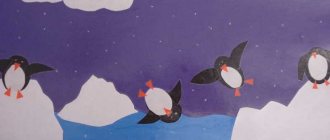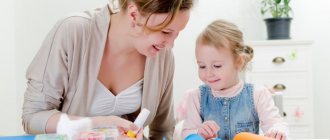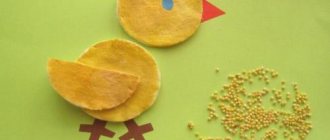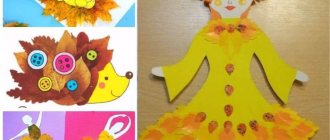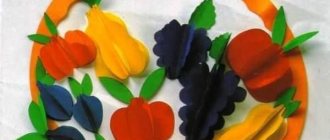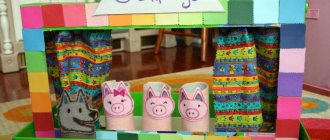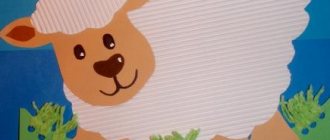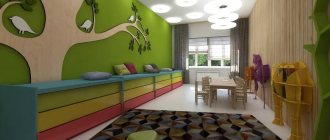- What is an application?
- How is the application useful for a child?
- A little about the types of applications
- Applications made from colored paper for children. What paper is needed for work?
- Circle applique ideas
- A few more volumetric applications
- Applications made from colored paper using templates
- A few more themes for colored paper applique
In this article you will get acquainted with applique, its types and find tips on creating children's crafts and ideas for them.
What is an application?
Applique is one of the types of arts and crafts designed to decorate the objects around us. We first encounter it in childhood, when an ordinary sheet of paper falls into our hands. That’s when miracles begin, because applique for a child is a kind of exciting game, magic, where he can create images by cutting, tearing, applying or combining materials on a base - a background.
Crafts “Christmas trees”
We offer you 4 options for how to make a craft with a Christmas tree. We will make cards, applications and a New Year's toy.
New Year's card "Delicate Christmas tree"
Let's make a postcard - a transformer. When closed, the Christmas tree looks like an ordinary one, but as soon as you open the postcard, the holiday begins!
Craft “Christmas tree” from a sleeve
Crafts made from bushings are a special love! Such affordable material and so many interesting things you can make from them, for example, a Christmas tree. To do this, we will fold the sleeve in half and make cuts. The final work can be used as a Christmas tree decoration. This craft can be done by children aged 3 years and older.
You can think about what a green beauty might look like in the “Living Christmas Tree” master class. Download the finished template. Children under 4 will need help cutting out as the lines are curved.
Or make an applique from paper circles. For children under 4 years old, make a lot of blanks from colored paper and show them how to fold them. Then they can handle it themselves! As an additional decoration, we use semolina, which is so similar to snow.
For older children (from 6 years old), we invite you to try out elements of the origami technique to create your own New Year’s cards. Three craft options for your choice!
Sources
- https://dnevnikmastera.ru/applikaciya-dlya-1-2-3-4-klassa
- https://urokirukodelie.ru/applikacziya-v-shkolu-1-2-3-4-klass/
- https://hobbi.guru/podelki-iz-bumagi-s-shablonami/
- https://podelochkin.ru/applikacziya-1-2-3-4-klass
- https://orechi.ru/podelki/novogodnie-podelki-iz-bumagi
- https://gamejulia.ru/origami-dlya-1-klassa.html
- https://svoimirukamy.com/podelki-iz-tsvetnoj-bumagi-dlya-mladshih-klassov.html
- https://svoimirukamy.com/applikatsii-iz-bumagi.html
- https://creativebaby.ru/50-zimnih-podelok-dlya-detey-s-shablonami/
[collapse]
How is the application useful for a child?
Children in early childhood (from about 1 year old) begin to be interested in this type of activity. This is precisely one of the opportunities to develop a child’s fantasy and imagination, study colors and their combinations, as well as the shapes of objects, and develop fine motor skills. Applique classes encourage the development of a child’s thinking processes; he creates a whole from several parts and learns to divide the whole into elements. And, of course, such creativity contributes to the development of speech and spending time together.
By doing appliqué, a child masters the skills of working with paper, scissors and glue, becomes familiar with the properties of paper, learns to work with simple drawings and diagrams, reads symbols and creates a complete image.
Applications for 1st grade
For schoolchildren who have just arrived at school, it is important to organize interesting lessons. For children at this age, working with colored paper, pencils, and scissors is exciting. They can work for a long time to create paintings of their own production.
In the first grade, it is important to capture the attention of craftsmen and teach them to think, develop and expand their horizons. It is necessary to add educational materials under humorous and playful moments during appliqué work. So, for example, when studying the topic of animals in the first grade, you can organize a lesson on the topic of creating an image of a particular animal using cut out figures.
In the class, you can give students various tasks on different animals; then, when the work is finished, you can describe the presented animal, thereby preparing a short story about it, i.e. make a presentation of your work.
At the age of seven, children love to play, they love fairy tales and their characters, so applications related to these children’s desires will be well received by them.
A little about the types of applications
By topic, the following types of applications can be distinguished:
- Subject - a simple type of application for children. An element is cut out of the material and glued to the base.
- Subject - the image no longer consists of one, but several links that make up an event or action in the background.
- Decorative - forms a repeating pattern that is used to decorate albums, frames and household items.
Paper is the main material for applique. However, in addition to it, you can use other materials, whatever your imagination allows: fabric, leather, multi-colored beads, seed beads, woolen threads, leaves, seeds, cereals and much more.
By color, the applique can be colored, black and white or single color.
Depending on the volume, flat and volumetric applications are distinguished.
Overhead, cut-off, silhouette, modular, ribbon... and this is not all types of applique!
And to understand how diverse this art technique is, it is enough to get acquainted with the most popular and interesting types of children's applications, examples of which are given below.
Theoretical foundations of teaching applications in technology lessons in primary school
Chapter 1. Theoretical foundations of teaching applications in technology lessons in primary school
1.1 Application implications for comprehensive development
Artistic and creative activity is an activity that occurs in a child under the influence of literary, musical or works of visual art. This same activity, in turn, has a huge impact on the comprehensive development of the personality of a preschool child. In this regard, let us cite the statement of L.I. Novikova, who claims that: “The theory and practice of education in preschool institutions have revealed that artistic and aesthetic activity has an incomparable impact on the overall development of the child; a healthy emotional sphere is formed, thinking is improved, the child becomes more sensitive to beauty in art and in life” [9, p.172].
In elementary school, fine arts activities are represented by such types as: modeling, drawing, design, appliqué. Each of these types has its own characteristics in displaying the child’s impressions of the world around him. Let us pay attention to the fact that when practicing appliqué, preschoolers become familiar with the simple geometric shapes of various objects, parts and silhouettes of which they cut out and paste on. Creating silhouette images requires a lot of thought and imagination, since the silhouette lacks details, which are sometimes the main characteristics of the object [3, p.47].
Having compared different interpretations of the concept of “appliqué”, we settled on the definition given by M. A. Gusakova: “Applique is the simplest and most accessible way of creating artwork, which preserves the realistic basis of the image itself” [4, p.20].
The main features of appliqué, continues M. A. Gusakova, “are silhouette, flat generalized interpretation of the image, uniformity of the color spot (locality) of large color spots” [4, p.25].
The following types of applications are used in kindergarten:
- subject, consisting of individual images (leaf, branch, tree, mushroom, flower, bird, house, person, etc.);
‒ plot, reflecting a set of actions, events (“Victory Salute”, “Flight into Space”, “The Birds Have Arrived”, etc.);
- decorative, including ornaments and patterns that can be used to decorate various items of clothing and household items.
In teaching applicative skills in a preschool educational institution, the following general tasks are solved:
1) compiling decorative patterns from various geometric shapes and plant details (leaf, flower), placing them in a certain rhythm on a cardboard or fabric base of various shapes;
2) compiling images of objects from individual parts; plot image;
3) mastery of various techniques for obtaining parts for appliqué from different materials, for example: cutting with various techniques, tearing, weaving; as well as the technique of attaching them to the base: gluing, sewing;
4) developing a sense of color, knowledge of primary colors and their shades, the ability to create harmonious color combinations;
5) formation of a sense of form, proportions, composition.
During applique classes, preschoolers become familiar with the simple geometric shapes of objects, the details of which they must cut out and paste. Thus, S.V. Arapova writes that: “Creating silhouette images requires a lot of work of thought and imagination, since the silhouette lacks details, which are sometimes the main features of the object” [6, p.35].
Also, applique classes contribute to the development of elementary mathematical concepts in preschoolers. Children, according to the authoritative opinion of T. S. Komarova, “get acquainted with the names and characteristics of the simplest geometric shapes, gain an understanding of the spatial position of objects and their parts (left, right, corner, center, etc.) and quantities (more , less)". These complex mathematical concepts are easily acquired by preschoolers in the process of creating a decorative ornament or when depicting an object in parts.
In addition, by doing appliqué, preschoolers develop a sense of rhythm, color and symmetry. On this basis, artistic taste is formed. As the team of authors rightly notes: E. A. Dubrovskaya, T. G. Kazakova, N. N. Yurina, “a big role in the applique belongs to its color design, which has a huge impact on the development of children’s artistic taste.” Color has an emotional impact on a child, captivating him with its colorfulness and brightness. Therefore, it is important to purposefully develop a sense of color as the most accessible idea of the beauty of the surrounding world and works of art [10, p.68].
By providing preschoolers with colored paper, the teacher develops in them the ability to select beautiful color combinations. At the same time, children do not need to make up colors or paint over shapes themselves. Applique encourages preschoolers to plan the organization of work, which is especially important here, since in this type of art “the sequence of attaching parts is of great importance for creating a composition (large forms are glued first, then details; in plot works, first the background, then background objects, obscured others, and last but not least the objects of the foreground).”
Performing applicative images contributes to the development of hand muscles and coordination of the child’s movements. Preschoolers learn to use scissors, carefully and correctly cut out shapes and parts, turn a sheet of paper, and lay out parts on a sheet at an equal distance from each other.
It should also be noted the role of appliqué classes in the labor education of preschoolers.
Preschoolers develop a work culture; they prepare the necessary materials and tools in advance, put their workplace in order, and plan the sequence of task completion. In preschoolers, general and fine motor skills of the hands are improved and coordinated, qualities such as accuracy, speed, and smoothness are formed. According to S. V. Arapova, “this becomes possible with systematic, planned classes, organization of independent artistic activities, consistent implementation of program requirements in each age group, gradual complication of tasks as experience is gained.” Preschoolers must learn to diversify the acquired skills in other types of artistic and creative activities [5, p.17].
Thus, the level of mastery of the skills and abilities provided for by the application program makes it possible to implement and determine the degree of readiness of each child for successful learning at school, further mastery of the content and techniques of various types of artistic craft.
1.2. Techniques for creating paper applique
The concept of “appliqué” includes methods of creating works of art from materials that differ in their properties and texture, united by the similarity of the execution technique. Each material has its own characteristics, which have a decisive influence on the application technique. For example, paper, straw, dried plants, birch bark are attached to the background with various adhesives; fabrics, leather, fur, felt are usually sewn on; poplar fluff is applied to velvet paper without glue.
Applique is the simplest and most accessible way to create artwork, which preserves the realistic basis of the image itself. This makes it possible to widely use appliqué not only for design purposes (in the production of visual aids, manuals for various games, toys, flags, souvenirs for holidays, decorations for festive and other costumes, design of wall newspapers, stands, exhibitions, kindergarten premises), but and in the creation of paintings, panels, ornaments, etc. The main features of the appliqué are silhouette, flatness, generalized interpretation of the image, uniformity of the color spot (locality) of large color spots [12, p.76].
Traditional appliqué techniques
The application can be substantive, consisting of individual images (leaf, branch, tree, mushroom, flower, bird, animal, house, car, person, etc.); plot, reflecting a set of actions and events. The applique is made by gluing or sewing pieces of one or another material of various colors onto the main background (paper, fabric, leather and other materials). The finished product made in this way is also called appliqué. According to their content, applications can be divided into: subject, plot, ornamental, and font. As a rule, they are made in multi-color or single-color (silhouette).
Subject appliques (leaves, fruits, vegetables, flowers, mushrooms, insects) are made from cut out geometric shapes. They are the simplest and most accessible for primary school students to complete.
Plot appliqués consist of several different figures, often made in motion, and serve to illustrate literary works: fairy tales, fables, poems. At the request of children, plots can be chosen on various topics (agriculture, industry, construction, science fiction, etc.).
Silhouette applique: all figures are cut out of paper of the same color. And very often beautiful silhouette scenes are obtained, cut out of light paper and pasted onto a dark background or vice versa.
Ornamental appliqués are used for the design of albums, wall newspapers, invitation cards, greeting cards, stage decorations, costumes, and decoration of work objects. In the design, a lot of space is given to text, and then the importance of font applications is great, when headings, slogans, posters, and educational tables are decorated with beautiful letters made of colored paper.
Based on the type of application, applications can be divided into flat and volumetric.
Flat applique is performed by cutting out parts from paper, fabric, leather and other materials, then gluing them onto a paper base.
Broken applique. In some cases, paper parts are made by tearing. The edges of such parts turn out uneven. This method of applique is good to use when depicting animals, trees, fluffy snow, or a fur hat. The torn edges of the parts create the impression of fluffiness and roughness [12, p.65].
Applique mosaic is made from small pieces of colored paper, which can be cut with scissors or prepared using the tearing method. Paper mosaics are used to create both contour and solid images.
Volume applique. Volumetric appliqué, which creates some appearance of volume, has become widespread in practice. It increases the artistic possibilities of student work and expands the creative capabilities of children.
Napkin applique is the optimal type of applique for working with preschool children. This is both easy and safe to perform, since no scissors are required. This can be an application of flagella and lumps, which just trains the coordination of movements of the fingertips.
From natural materials - Dried leaves are a wonderful material for artistic combination. The different shapes of the leaves themselves will tell us what can be created from them. A maple leaf resembles a hedgehog and an octopus, an oak leaf resembles the tail of a fish, a poplar or birch leaf resembles the head of a fox, bear, dog, cat, etc.
This is a great opportunity for children to pick up, apply, arrange and experiment with leaves.
Paper applique can be single-layer or multi-layer. Single-layer work includes those works in which the parts are glued in one layer completely or partially. When performing a multi-layer appliqué, smaller parts of a different color are glued onto large parts in two or three layers.
Fabric applique - Pieces of fabric are widely used in circle classes. The flowers and leaves you like are cut out from them. Then a basket or vase cut out of colored paper is glued onto the paper base. Flowers and leaves made of fabric are arranged into bouquets and glued, creating the necessary composition [13, p.17].
Innovative appliqué techniques
This type of application includes a relatively young technique – quilling. Quilling is the art of making three-dimensional compositions from long and narrow strips of paper twisted into spirals.
In English, this handicraft is called “quilling” - from the word “quill” or “bird feather”. Unlike origami, which originated in Japan, the art of paper rolling originated in Europe in the late 14th and early 15th centuries. In medieval Europe, nuns created elegant medallions by twisting paper with gilded edges onto the tip of a bird's feather. When viewed closely, these miniature paper masterpieces created the complete illusion that they were made of thin gold strips. Unfortunately, paper is a short-lived material and little has survived from medieval masterpieces. However, this ancient technique has survived to this day and is very popular in many countries around the world. Paper rolling quickly spread in Europe, but because paper, especially colored and high-quality paper, was a very expensive material, paper plastic art became an art for ladies from the wealthy classes.
In England, Princess Elizabeth was seriously interested in the art of quilling, and many of her creations are kept in the Victoria and Albert Museum in London. We associate paper with the idea of fragility and fragility. But quilling refutes this statement - you can put, for example, a cup or a heavy book on a filigree volumetric stand, and not a single curl of paper lace will be harmed. You can assemble a candy vase from paper elements and safely use it for its intended purpose - it will not fall apart or break. In general, quilling is an opportunity to see the unusual possibilities of ordinary paper.
Also one of the new techniques for us is Iris folding.
Iris folding Iris Folding (iris folding) - filling the picture cut out along the contour with multi-colored stripes. Iris folding originated in Holland. This technique is also called "rainbow folding".
The technique of folding strips into a rainbow spiral is called iris folding. This technique originated in Holland (the Netherlands), local craftsmen folded their work in multi-colored stripes. This needlework technique is still little known in Russia. It is not as complicated as it seems at first glance, the main thing is to be careful and careful.
This technique creates the effect of a three-dimensional image, so the works look unusual.
There is special paper designed for Iris folding, but regular colored paper will also work. Fabric, wrapping paper, pages of old glossy magazines, floral paper and much more can also be used for crafts. It all depends only on your imagination.
Its principle is as follows:
1. The selected fragment of the picture is cut out along the contour.
2. On the reverse side, strips of colored paper are glued onto the drawing strictly in a certain order, in accordance with a pre-prepared template or a diagram.
3. The wrong side is sealed with a clean sheet of paper.
4. The application, if necessary, is supplemented with details.
There are many diagrams, templates and pictures for technology. At the same time, the schemes for iris folding are quite simple to make yourself. All children who can hold scissors will enjoy working with new technology. For small children (5-6 years old), it is better to prepare a diagram, but older children can draw it themselves.
Applications made using the iris folding technique are an excellent decoration for greeting cards, collages, book covers, bookmarks, notes and photo albums.
Applications made from colored paper for children
If you want to do any work, take into account that the proposed examples of applications have different levels of complexity and require different amounts of time.
For most crafts you will need:
- Colored paper
- Cardboard
- Glue
- Scissors
- Markers
What paper is needed for work
The beauty of the applique depends not only on carefully cutting out the parts and carefully gluing them to the background, but also on the materials used. Here are some tips for choosing paper for crafting:
- It is better to choose medium density sheets.
- Unlike gloss, fingerprints and glue marks will not be visible on matte paper.
- You can use thick matte paper made for printers.
- Textured paper focuses attention on the details of the craft.
- Foil sheets will make the applique or its details close to reality.
- When using self-adhesive, no glue is needed.
- Drawing paper is suitable for creating a template.
- Cardboard is best used as a background for applications.
Circle applique ideas
If the work is made entirely of circles, it will turn out unusual and interesting. For example, in order to create a fish, you will need a large circle of paper.
Two smaller circles, bent in half, form a tail at the edge. Many circles of the same size, also folded in half, will create the illusion of scales and fins.
When the elements are glued to the base, they form a three-dimensional appliqué. From such circles you can create many other animals or many plants.
A few more volumetric applications
Ladybug is easy to make. Cut out two circles from red paper and two half-ovals from black. We bend the circles in half and glue one half onto the base. We attach the semi-oval head in the middle above the circles. All that remains is to draw black dots on them and add eyes and antennae to everything.
In this way, you can make voluminous “fruit” and “berry” applique – apples, cherries.
Applications made from colored paper using templates
A template is a device for marking one or several parts of a drawing, repeating their shape.
Applications “Summer”, “Autumn”, “Winter”, “Spring” open up enormous scope for the development of imagination.
In a plot applique, you can take any fairy tale plot and break it down into small elements. Birds, butterflies, animals, clouds, flowers are possible templates for children when creating a summer applique.
You can make a beautiful basket with flowers. You need to prepare a basket template that will serve as the background for the craft. We glue the basket onto cardboard so that it holds well. Using a template, cut out circles of bright colors from a sheet of paper: yellow, red, blue. The middle of the circle needs to be pressed with a pencil and glued in place. To get more voluminous flowers, glue a smaller circle in the middle in the same way.
A few more themes for colored paper applique
The broken applique of lilac flowers turns out to be so lush that it looks quite realistic.
It is worth using white, pink or purple napkins. You need to cut out a silhouette of a pre-designed shape and size of the inflorescence from a colored napkin. Then glue it onto the base. Next, cut the napkins into small squares. We crumple some of them right away, others we also crumple, but first we tear them into pieces. We glue the lumps to the silhouette so that there is no gap between them. The flower is ready!
By drawing an outline in advance and choosing the necessary colors, you can create a masterpiece from pieces. For example, for a bear cub you will need paper in brown, black, yellow, white and red. The broken pieces should be approximately the same size and fit together like a puzzle.
For the next application, you need to place the child’s palm on a sheet of paper and circle it. We cut it along the contour and glue it onto the base, except for the fingers that will hold the bouquet (as shown in the photo).
Next, cut out multi-colored flowers and glue them with the centers onto the bouquet. We bend our fingers and... the craft is ready!
Applications made from colored paper are a creative process through which children learn about the world around them and acquire a lot of skills. There are many varieties of applications, the main thing is that it brings genuine joy and interest to the person who creates them. Create, fantasize, experiment, it's so simple!
Applications for 2nd grade
As the baby grows, his needs in terms of understanding the world around him grow. Teachers need to make appliqué classes more complex; they should be more creative and beautiful. Practical skills and developing experience are important for 2nd grade students. In the 2nd grade, children are already accustomed to school, they begin to understand that it is important to develop their abilities independently, try to read and memorize more, and write down important points in notes.
Photo ideas for interesting children's applications made from colored paper
leave a comment
